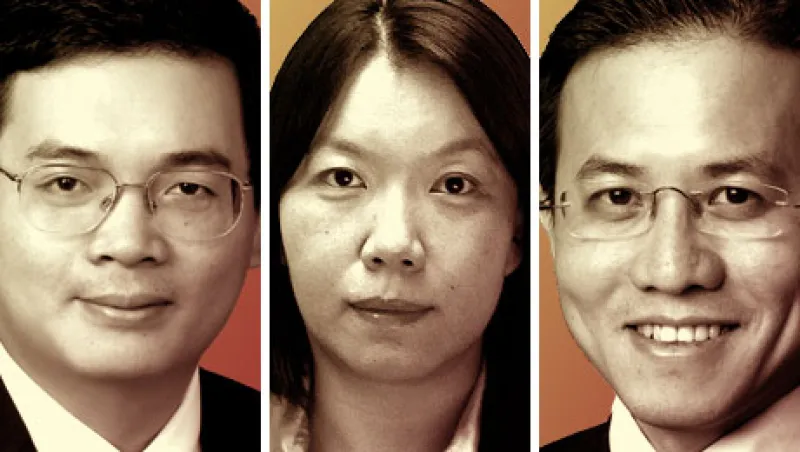More than four years of bear markets in China may scare away many investors, but Matthew Vaight, manager of London-based M&G Investments’ £1.7 billion ($2.7 billion) Global Emerging-Markets Fund, isn’t afraid. In fact, he believes the time is ripe for considering increasing exposure to the world’s second-largest economy.
“There is value in China today,” Vaight declares. “Investors appear to be focusing on the risks from the banking sector and politics, and this is reflected in valuations. Two members of our investment team are on a research trip to China at the moment, which indicates that we are identifying value and opportunities there. What excites us about China is that it is a huge market that offers plenty of opportunities for bottom-up stock pickers.”
Money managers often look to brokerages for assistance in finding winning investments, and this year China International Capital Corp. cements its position as the nation’s most highly regarded provider of sell-side equity research. The firm not only repeats atop Institutional Investor’s All-China Research Team roster but also increases its team-position total by six, to 25, and doubles its number of first-place appearances, to ten. Bank of America Merrill Lynch returns at No. 2, with 16 spots — one fewer than in 2012 — followed again by Citi in third with nine positions.
Credit Suisse slips one notch to share fourth place with last year’s No. 10 firm, Goldman Sachs (Asia). Each has a team-position total of six; Credit Suisse loses three, while Goldman gains an equal number. This year’s results reflect the opinions of more than 970 investment professionals at some 450 institutions that manage an estimated $613 billion in Chinese equity assets.
CICC’s victory is all the more impressive in light of the fact that over the past year it cut its research department head count by nine, to 68, while expanding its coverage universe by 59, to 685 stocks, according to Hong Liang, Beijing-based head of research.
“We are taking a relatively more positive stance toward the market, as we believe investors may underestimate the resolve and capability of the new leadership to deliver far-reaching reforms in the coming years,” Hong explains. “As a result, they may underestimate China’s growth potential as well as its corporate earning capabilities. For the next six to 12 months, we think the risk and rewards begin to favor many large state-owned enterprises with historically low valuations, potential reform tailwinds and the improved growth outlook globally.”
Xi Jinping and Li Keqiang, who became president and premier, respectively, in March, are pushing through a series of economic and financial reforms, chief among them expanding foreign investor involvement in China’s capital markets. Also on the policy agenda is deregulation that will increase private sector and foreign participation in a wide range of industries, a key focus of the central government’s 12th Five-Year Plan that seeks to chip away at the nation’s reliance on government-led investments as the primary growth driver and move toward a more consumer-centric economy.
“Client interest in China remains robust,” confirms Angello Chan, who directs coverage of Chinese equities at BofA Merrill in Hong Kong and also scores a runner-up spot in Public Utilities. “Despite some structural concerns in shadow banking, our view is that China remains an inexpensive market from a valuation perspective and potential reforms are likely to unlock value in many state-owned sectors.”
There’s certainly room for improvement. The CSI 300, an index that tracks China’s largest Shanghai- or Shenzhen-listed companies by market capitalization, closed October at 2,373.72, down more than 37 percent from its high of 3,787.03 in August 2009. Continuous bear market conditions in China have made investors “more eager to know the possible reforms in the next five years and, more importantly, which sectors or stocks will be key beneficiaries and bring them any investment opportunities,” observes Shen Minggao, Citi’s Hong Kong–headquartered director of China research.
However, the nation’s most deeply entrenched problems are not the ones that tend to attract the lion’s share of attention from investors — or policymakers, according to BofA Merrill’s Ting Lu, who rises one rung to finish in first place for the first time in Economics.
“The biggest challenges facing China are not increasing public debt and nonperforming loans, shadow banking, manufacturing overcapacity and property bubbles,” the Hong Kong–based economist insists. “China needs to address challenges such as crony capitalism, the widening wealth inequality, the shrinking young labor force, environmental degradation and relationships with other global powers. The key risk is the development gap between the existing rigid political system and the newly economically empowered middle class who seek more accountability on the part of the government and are increasingly equipped with access to the Internet, mobile phones and social media.”
These newly emboldened consumers are playing a progressively prominent role in China’s growth, according to CICC’s Haiyan Guo, who jumps from third place to land on top for the first time in both Consumer/Discretionary and Consumer/Nondiscretionary. “The consumer discretionary sector — retail and home appliances — is picking up and recovering in a moderate pace as a whole,” the Beijing-based analyst says. “Going forward, we see overall consumption data continuing to gradually recover, with various hot spots in the coming season. We favor companies that meet mass consumer needs, promote multichannel strategies and reform efficiency.”
One example: Haier Electronics Group Co. The Hong Kong–based manufacturer “is committed to building a combination of both an online and offline distribution system, in the service of household appliances and furniture,” Guo believes. She dubbed the stock a top pick at the start of the year, and by the end of October, it had risen 45.9 percent. During the same period the MSCI All-China Index was flat.
Consumers are also behind the rising demand for power — clean energy in particular, notes the top-ranked researcher in Public Utilities, Citi’s Pierre Lau. “China’s utility sector is a growth story, with faster growth in clean-energy-related areas amid the government’s emission cuts and environmental-protection moves,” says Lau, who is one of only three analysts to have consistently appeared at No. 1 in his or her sector since the team was introduced in 2010. (The others are Lau’s colleague Kam Keung [Oscar] Choi in Real Estate and Morgan Stanley’s Bin Li in Health Care.) “The challenges often come from higher costs in using clean energies such as natural gas, wind and solar compared to coal. But the growth opportunities are often endorsed with favorable government policy.”
The Hong Kong–based researcher’s top picks for 2013 include Beijing-based Huaneng Renewables Corp., an alternative-energy provider that is part of government-controlled power producer China Huaneng Group Corp. “The rationale behind our positive view was the rapid growth in the wind industry and the company’s fastest capacity growth among its peers,” Lau explains. The stock soared 118.2 percent year to date through October, and it remains a favorite.
“China’s energy space is always dynamic and eventful,” agrees Bin Guan, who outperforms his peers in Energy for a second year running. “There should be many growth stories given China’s huge energy needs, big structural-adjustment opportunities, efficiency upside and market-liberalization potential.”
Hilong Holding, an oil field equipment and services provider headquartered in Shanghai, is among the CICC analyst’s winning names for 2013; the stock surged 94 percent year to date through October. Guan, who works out of Hong Kong, cites two reasons for his recommendation: Hilong’s “growth potential and management quality.”
Government policy is having a less beneficial effect on other sectors. “Tightening environmental oversight in China is putting unprecedented pressure on the industry,” reports CICC’s Zheng Gao, who climbs from second place to claim her first appearance atop the roster in Basic Materials. “We will be continuously looking for the opportunities that could arise under tightening environmental oversight — namely, cyclical opportunities from supply contraction caused by the elimination of obsolete production facilities owing to stricter environmental requirements, and growth opportunities from the surging demand for new materials to meet environmental requirements.”
Companies that meet these criteria, the Shanghai-based researcher says, include such producers of biofermentation-based additives as Fufeng Group, which is headquartered in Jinan, and Langfang City’s Meihua Holdings Group Co.
Despite its best efforts, including requiring higher down payments for homes and restrictions on the sale of farmland for commercial development, Beijing has had little success in dampening enthusiasm for real estate — and that’s not likely to change, believes Citi’s Choi. “China’s property sector’s fundamentals are intact, with our forecast of sales [anticipating] a compound average growth rate of around 30 percent through the end of this year and 25 to 30 percent through 2014,” he says. “Margins are decent, financial positions have significantly improved, and overall valuation looks attractive.”
Shanghai-based Shimao Property Holdings, a diversified developer with a large portfolio of both residential and commercial properties, has been among the Hong Kong–based analyst’s top picks since early last year. “We like Shimao’s new management team, led by vice chairman Jason Hui,” he says. The executive team’s recent emphasis on asset turnover helps explain its compound average annual sales growth rate of 50 percent, he adds. Shimao shares bolted 38.4 percent year to date through October.
Companies that adapt to shifting market conditions also attract the notice of Wai (Eddie) Leung. The BofA Merrill analyst, now in his second straight year at No. 1 in Internet, urges clients to “buy and hold quality companies with leading positions in certain segments, while keeping a close eye on structural changes that may make their business models obsolete,” he says.
The analyst, who is headquartered in Hong Kong, includes two Nasdaq Stock Market–listed companies among his current favorites: Beijing-based search-engine operator Baidu, whose shares shot up 60.3 percent year to date through October, and Shanghai’s Ctrip.com International, an online travel-services provider whose stock skyrocketed 139.5 percent.
“We also recommend that investors stay nimble to leverage the sector’s volatility and catalysts,” Leung adds.
That advice applies to the market as a whole, asserts M&G’s Vaight. “The economic model in China is changing,” he says. “Many Chinese companies realize that having a competitive advantage based solely on cost is not a sustainable, long-term strategy. Companies to watch are ones that are outsourcing their manufacturing to keep their costs down — for example, to inner China or to cheaper countries such as Vietnam — and ones that are investing in research and development and branding.”
Get more of our research and rankings.






